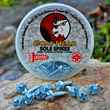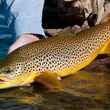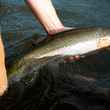Sometimes, what one perceives as undesirable or troublesome becomes sought after by others. One man’s trash, they say, is another’s treasure. This summer, spongy moths (Lymantria dispar dispar), formerly known as “gypsy” moths, fully matured, taking flight and wreaking havoc on our local hardwood stands. Though they wrought destruction on our local forests, these fuzzy invaders became a favorite food source for smallmouth bass on local rivers.
This July was a record-breaking topwater bass season for me. Fish that live in my favorite smallmouth waters took notice of these moths, creating some of the best surface bass action I’ve had in years. And it wasn't just the fish that were feasting. Squirrels, countless birds, and other animals fed with reckless abandon on these fluttering, protein-filled snacks, letting down their guard as they gorged themselves.
There’s a red pileated woodpecker that lives behind my house whom I’ve tried and failed to photograph countless times, due mostly to my lack of stealth. Anytime I’ve gotten within 60 feet, it would become aware of my presence and take off. But my luck changed in July, during the peak of the spongy moth hatch. I heard the woodpecker working a dead pine tree, and found it not only boring into the wood for insects, but also targeting the countless spongy moths which landed on its limbs. Instead of spooking at my presence, the bird obliviously pigged out. Easily, I crept within 30 feet and was able to capture several images of the otherwise elusive creature.
The bass, for their part, followed the woodpecker’s lead. The feeding frenzy was so intense that I would compare it to hatches like the eastern green drake, Hexagenia, and grannoms — even the 17 year cicada emergence.
No Stealth Required
Large smallmouth are spooky and require both distance and stealth to catch — unless they’re gorging on spongy moths, that is. On one outing, after my boatmate had landed a great fish, we anchored beside the bank, where I jumped out to capture a photo. We took no particular care not to cause a commotion, moving with haste through the water, snapping pictures, and quickly releasing the fish. Normally, this sort of ruckus would be more than enough to put down any nearby fish for a period of time. But this day, several large smallmouth confidently crushed spongy moths mere feet from our boat — not only after we’d finished our business in the water, but as we leapt into the water and moved about. After releasing the bass, not 10 feet away freshwater sharks cruised the surface, creating wakes as they hunted struggling moths on the water's surface. We remained anchored in the same spot, catching several of these large fish before moving on. Only during the periodical cicada emergence have I ever seen large smallmouth let their guard down this much.

Finding the Frenzy
The fishing, you’ve likely already surmised, was easy. The difficult part, however, was finding pockets of spongy moths. For the most part, this meant finding areas where spongy moth treatments — typically accomplished via aerial or other spraying of a bacteria that affects only spongy moths and not other insects, bees, animals or people — hadn’t taken place. Much of the state forest surrounding my homewaters was treated for spongy moths. Pockets of private land, we discovered, often went untreated.
Both male and female spongy moths have wings, but only males can fly. The greatest action occurred where flightless females fell off overhanging limbs. Large bass quickly learned of these new feeding zones — where we’d typically find dozens of high teens to twenty-inch bass hunting. During the hottest part of the day, we would jet up and down various river sections looking along the banks for spongy month swarms. Interestingly, these hot zones were only so during the spongy moth infestation. Large bass were nowhere to be found after the infestation concluded.

The Window
While fish will eat a fallen spongy moth caterpillar, it appears they prefer the moth stage. The length of surface action is like many of our eastern trout hatches — 1 to 2 weeks. Adult spongy moths live for about 7-10 days after becoming a winged adult. We witnessed heavy hatching activity around July 2, creating excellent smallmouth topwater action, but action came to a dead halt by the middle of July.
Flies and Presentation
When female moths fall to the water, often their wings frantically vibrate, sending an SOS signal to any nearby smallmouth. Though we noticed countless females falling to the water, the ones that received immediate attention were those vibrating their wings on the surface. The resulting scene was reminiscent of Jaws, with smallmouth cruising the surface with their dorsal fins out of the water as they hunted panicked swimmers.
While the smallmouth gorged themselves on spongy moths, just about any surface popper (of varying color and size) produced strikes. Though the fish were unquestionably in pursuit of fallen moths, they weren’t the least bit opposed to eating, say, a large fluorescent yellow boogle bug. With few exceptions, large, resident fish would eat any fly floating on the surface provided it was drifting at the same speed as the current and presented with a vibrating pulse. Creating this pulse was as simple as vibrating the rod hand during the drift, causing the rod tip to send a pulse down the line and leader and into the fly — imparting just enough action to wiggle the legs and create a barely perceptible wake on the surface. As is often the case, less is more when attempting to create a disturbance with a surface pattern to attract bass suspended near the surface.
Unsurprisingly, tippet size also didn’t matter, as we used 0X during the entire two-week feeding frenzy despite fishing low and clear water.

Final Word
As a property owner with a nice stand of timber, I prefer to not have spongy moths in our area. But it’s clear that our resident smallmouth bass look forward to each heavy infestation. So I’ll be ready with a fly rod and poppers for the next go-round and you should be, too. In preparation, it may be useful to learn where spongy moth treatments will and will not occur. If you can find untreated areas along major bodies of water, you may just find some of the best topwater smallmouth action of the season.

































Comments